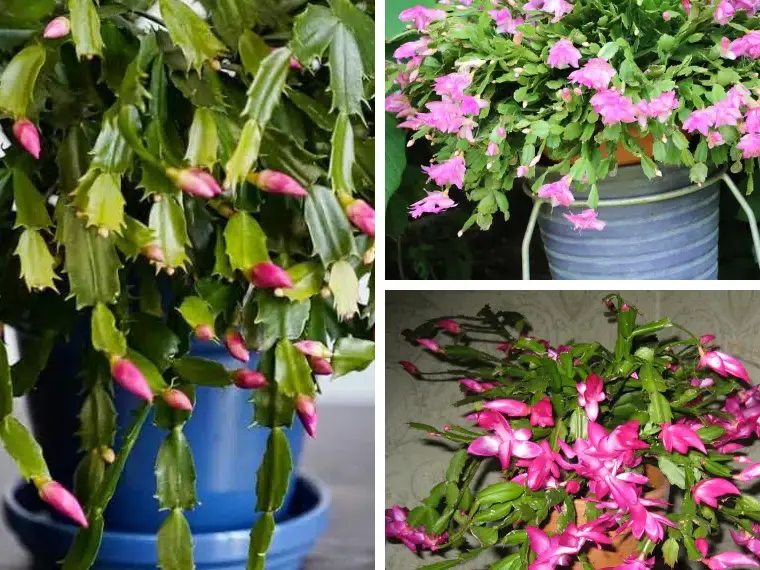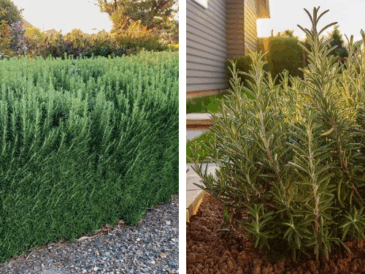If you’ve ever been surprised by vibrant pink, red, or white blossoms cascading from a cactus in the middle of November, you’ve likely met the Thanksgiving cactus – one of the most beloved houseplants for the holiday season.
Understanding the Thanksgiving Cactus (Schlumbergera truncata)
The Thanksgiving cactus (Schlumbergera truncata) belongs to the holiday cactus trio – along with the Christmas cactus (S. bridgesii) and Easter cactus (S. gaertneri).
Although they look similar, each has unique blooming times and leaf shapes.
- Thanksgiving cactus: Blooms in November, with pointed, claw-like edges on each leaf segment.
- Christmas cactus: Blooms in December, with rounded leaf edges.
- Easter cactus: Blooms in spring, with star-shaped flowers and flat leaves.
Thanksgiving cactus is the earliest bloomer and often the easiest to encourage into flower, making it a favorite for brightening autumn homes just before the holidays.
Natural Growth Habit
In its native tropical forests, the Thanksgiving cactus grows high in tree branches, where the air is humid, light is filtered, and temperatures are mild year-round.
This means it prefers indirect light, consistent moisture, and good air circulation – quite different from desert cacti that thrive on neglect.
Thanksgiving Cactus Care Basics
Light
Thanksgiving cactus thrives in bright, indirect light. Too much direct sun scorches its leaves, while too little light delays flowering.
- Best indoor spot: Near an east-facing or north-facing window.
- Outdoor summering: Move it outside in bright shade during summer months, but bring it indoors before temperatures drop below 55°F (13°C).
Tip: If your cactus develops reddish or purple leaf edges, it’s likely getting too much sun.
Temperature
This plant loves mild, stable temperatures.
- Ideal range: 60–70°F (15–21°C) by day, slightly cooler at night.
- During bud formation: Cooler nights (55–60°F / 12–15°C) help trigger flowering.
Avoid drafts or sudden temperature swings, which can cause buds to drop before they open.
Watering
Thanksgiving cactus needs more water than typical cacti but less than tropical houseplants. The key is balance.
- During active growth (spring to fall): Water when the top inch of soil feels dry.
- During blooming season: Keep soil slightly moist to support buds.
- During rest period (after flowering): Allow the soil to dry out more between waterings.
Always water thoroughly, allowing excess to drain out – soggy roots lead to rot quickly.
Pro tip: Use room-temperature, filtered, or rainwater if possible, as these plants are sensitive to hard tap water.
Humidity
Because it’s native to humid forests, Thanksgiving cactus enjoys moderate to high humidity (50–60%).
If your home air is dry during winter heating, try:
- Placing a humidifier nearby,
- Grouping plants together, or
- Setting the pot on a tray filled with pebbles and water (without letting roots touch the water).
Proper humidity not only prevents shriveled stems but also helps buds develop fully.
Soil
Use a well-draining, slightly acidic potting mix. The best mix mimics its epiphytic nature – airy and loose, allowing roots to breathe.
Recommended mix:
- 2 parts peat or coco coir
- 1 part perlite or pumice
- 1 part orchid bark or coarse sand
Avoid heavy garden soil or standard potting mixes that retain too much moisture.
Fertilizing
Feed your Thanksgiving cactus lightly throughout the growing season.
- Spring to late summer: Use a balanced, water-soluble fertilizer (10-10-10 or 20-20-20) every 4–6 weeks.
- Early fall (September): Stop fertilizing to allow the plant to enter dormancy and prepare for blooming.
Too much fertilizer – especially nitrogen – produces leafy growth at the expense of flowers.
Repotting
Thanksgiving cacti bloom best when slightly root-bound, so repotting should only happen every 2–3 years -preferably in spring, after flowering has ended.
Choose a pot only one size larger and refresh the soil mix. Always ensure good drainage.
How to Get Your Thanksgiving Cactus to Bloom
Getting a Thanksgiving cactus to bloom is all about mimicking its natural seasonal cues. In the wild, these cues are shorter days and cooler nights as autumn approaches.
Follow these steps carefully, and your cactus will reward you with spectacular blooms year after year.
Step 1: Provide a Resting Period (Late Summer to Early Fall)
After its growth phase in summer, your cactus needs a short rest.
From late August to September, reduce watering and stop feeding. Keep the plant in a cooler, darker location (around 60°F / 15°C).
This signals to the plant that the growing season has ended – preparing it to form buds.
Step 2: Trigger Bud Formation (October)
In early fall, begin a six-week “short-day” treatment:
- Light: Give your cactus 12–14 hours of total darkness each night and bright, indirect light during the day.
You can move it to a dark closet or cover it with a box from evening until morning. - Temperature: Maintain 55–60°F (12–15°C) at night.
- Water: Keep soil slightly moist but never wet.
After about 4–6 weeks, small buds should start forming at the ends of the leaf segments.
Pro tip: Avoid moving the plant once buds appear – temperature or light changes can cause them to fall off.
Step 3: Move to a Bright Spot Once Buds Appear
When buds are visible, move your cactus back to its regular bright location. Resume light watering and keep temperatures steady (60–70°F).
Within a few weeks, the buds will open into colorful, tubular blooms – often just in time for Thanksgiving.
Step 4: Maintain During Blooming
During flowering, the Thanksgiving cactus appreciates:
- Slightly more water than usual (never soggy)
- Even lighting (avoid harsh sunlight)
- Cooler nights to extend bloom time
Blooms typically last 4–6 weeks if conditions are right. Once they fade, reduce watering again to help the plant rest.
Step 5: Post-Bloom Care
After blooming, your cactus enters a short dormancy (about 6 weeks). During this time:
- Keep it in a cool, shaded place (55–65°F).
- Water sparingly.
- Avoid fertilizing.
When new growth appears in early spring, resume regular care and feeding.
Common Problems and How to Fix Them
Even with good care, your Thanksgiving cactus may face some challenges. Here’s how to troubleshoot common issues.
1. No Blooms
Causes:
- Too much light at night (interrupting the dark cycle)
- Temperatures too warm during bud formation
- Overfertilizing with nitrogen
Fix: Recreate the 6-week cool and dark treatment in fall. Avoid artificial light exposure at night (even from nearby lamps).
2. Bud Drop
Causes:
- Sudden temperature or light changes
- Overwatering or underwatering
- Moving the plant after buds appear
Fix: Keep the environment stable. Once buds form, leave the plant in one location and maintain consistent moisture.
3. Limp or Shriveled Stems
Causes:
- Too much or too little water
- Low humidity
- Root rot from soggy soil
Fix: Check roots for rot and repot if necessary in fresh, well-draining mix. Adjust watering schedule and add humidity.
4. Yellowing Leaves
Causes:
- Direct sunlight
- Poor drainage
- Nutrient deficiency
Fix: Move to bright but indirect light. Refresh soil and apply a diluted balanced fertilizer during the growing season.
5. Wilting After Blooming
Causes: The plant is naturally entering dormancy after flowering.
Fix: Reduce watering and place it in a cooler spot for several weeks to rest.
How to Propagate Thanksgiving Cactus
Propagation is simple and an excellent way to share this beautiful plant.
- In spring or early summer, cut 2–3 leaf segments from a healthy stem.
- Let the cut ends dry for 24 hours.
- Insert into a slightly moist mix of peat and perlite.
- Place in bright, indirect light.
Roots form within 3–4 weeks, and new plants can bloom within 1–2 years.
Best Companions and Display Ideas
Thanksgiving cactus pairs beautifully with other holiday greenery. Combine it with:
- Cyclamen for a winter bloom contrast.
- Ferns or Pothos to create lush, cascading displays.
- Christmas cactus or poinsettia for festive arrangements.
Display ideas:
- On a bathroom windowsill where humidity stays high.
- In hanging planters where blooms can cascade.
- On a decorative table centerpiece during holidays.
Its rich green stems and jewel-toned flowers make it a natural choice for cozy seasonal decor.
How Long Does a Thanksgiving Cactus Live?
With proper care, these plants can live 20–30 years or more. Many gardeners inherit theirs from parents or grandparents, continuing a tradition of holiday blooms passed through generations.
Each year’s flowering cycle becomes easier once you learn its rhythm – growth in spring, rest in summer, buds in fall, and a show-stopping bloom in late autumn.
Quick Seasonal Care Calendar
| Season | Care Focus | Key Tasks |
|---|---|---|
| Spring | Growth phase | Resume watering & fertilizing lightly |
| Summer | Maturity | Keep in bright shade, water regularly |
| Fall (Sep–Nov) | Bud formation & bloom | Provide cool temps, long nights, even moisture |
| Winter (Dec–Jan) | Rest period | Reduce watering, allow partial dormancy |
The Thanksgiving cactus is more than a seasonal decoration – it’s a living reminder of patience and care.
Each year, when those buds finally burst open, they fill your home with warmth and color right in time for the holidays.




